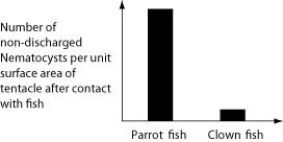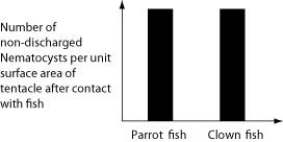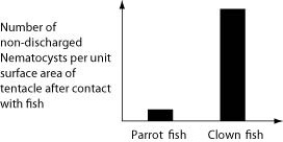Multiple Choice
Use the following information to answer the question.
An elementary school science teacher decided to liven up the classroom with a saltwater aquarium. Knowing that saltwater aquaria can be quite a hassle, the teacher proceeded stepwise. First, the teacher conditioned the water. Next, the teacher decided to stock the tank with various marine invertebrates, including a polychaete, a siliceous sponge, several bivalves, a shrimp, several sea anemones of different types, a colonial hydra, a few coral species, an ectoproct, a sea star, and several herbivorous gastropod varieties. Lastly, she added some vertebrates-a parrot fish and a clown fish. She arranged for daily feedings of copepods and feeder fish.
Normally, the clown fish readily swims among the tentacles of the sea anemones; the parrot fish avoids them. One hypothesis for the clown fish's apparent immunity is that they slowly build a tolerance to the sea anemone's toxin. A second hypothesis is that a chemical in the mucus that coats the clown fish prevents the nematocysts from being triggered. Which of the following graphs supports the second, but not the first, of these hypotheses?
A) 
B) 
C) 
D) 
Correct Answer:

Verified
Correct Answer:
Verified
Q22: Which phylum is characterized by animals that
Q73: Parasitism is one of the most widespread
Q74: Imagine that you are a graduate student
Q76: Use the following information and figures to
Q77: Use the following information and figure to
Q78: Use the following information to answer the
Q79: Use the following information and figures to
Q80: Use the following information to answer the
Q81: A terrestrial animal species is discovered with
Q82: The water vascular system of echinoderms _.<br>A)